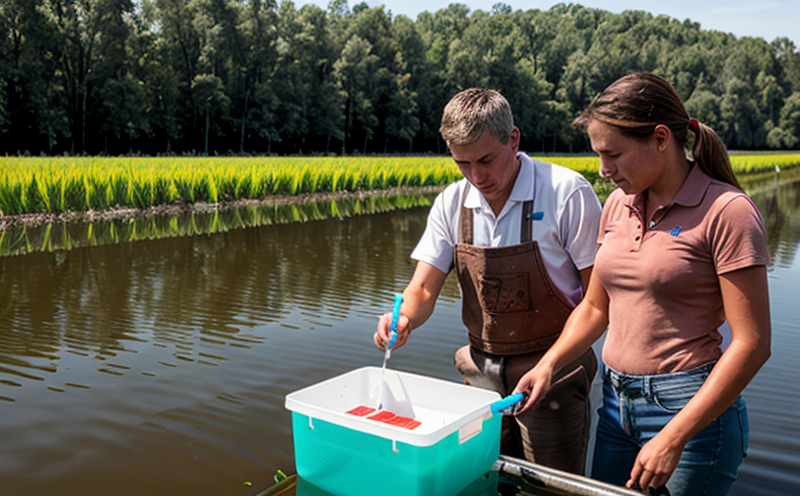Dissolved Oxygen (DO) Testing in Irrigation Water
Dissolved oxygen (DO) testing is a critical component of water quality analysis in agriculture and forestry, particularly when dealing with irrigation water. In the agricultural sector, ensuring that irrigation water contains adequate levels of dissolved oxygen supports plant health and overall crop productivity. Dissolved oxygen plays a pivotal role in the metabolic processes of plants, affecting photosynthesis and respiration rates. Insufficient DO can lead to stress on crops, reduced yield, and increased susceptibility to diseases.
The measurement of DO is essential for compliance with environmental regulations and sustainable agricultural practices. By accurately measuring dissolved oxygen levels, farmers can optimize irrigation schedules, thereby reducing water consumption and energy costs. This not only promotes sustainability but also contributes to long-term environmental stewardship by minimizing the negative impact on local ecosystems.
In terms of instrumentation, there are various methods for DO testing in irrigation water. Commonly used devices include electrochemical sensors, which rely on a platinum cathode, silver anode, and electrolyte solution to measure the oxygen concentration directly. Another technique involves the use of optical probes that emit light through a cuvette filled with the sample water. The amount of light absorbed is then related to the dissolved oxygen content.
The testing process typically begins with proper sampling of the irrigation water. It is important to ensure that the sample is representative of the entire body of water being tested. This involves collecting multiple samples from different locations and depths, if applicable. Once collected, these samples are analyzed using the chosen DO measurement device. The results provide a clear picture of the dissolved oxygen levels in the irrigation water.
Acceptance criteria for DO testing vary depending on specific agricultural practices and environmental standards. For example, compliance with ISO 6388:2017 ensures accurate and reliable measurements. In many cases, target levels are set based on crop type and local climate conditions. Crops such as rice or wetlands often require higher dissolved oxygen levels due to their anaerobic growth requirements.
| Crop Type | Target DO (mg/L) |
|---|---|
| Rice | > 2 mg/L |
| Grapes | 6-8 mg/L |
| Wheat | 4-5 mg/L |
Environmental and Sustainability Contributions
The importance of dissolved oxygen testing in irrigation water extends beyond mere compliance with regulations. By maintaining optimal DO levels, farmers can contribute significantly to environmental sustainability. Proper management of dissolved oxygen helps prevent eutrophication by reducing the proliferation of harmful algal blooms that thrive in low-oxygen environments.
Eutrophication is a natural aging process of aquatic ecosystems but can be accelerated by human activities such as nutrient runoff from agriculture. By ensuring adequate DO levels, farmers help mitigate this effect, promoting healthier water bodies and supporting biodiversity. Additionally, sustainable irrigation practices that include accurate DO testing contribute to the reduction in overall water usage, which is critical in regions facing water scarcity.
- Reduces the risk of algal blooms leading to eutrophication
- Promotes healthier aquatic ecosystems and biodiversity
- Minimizes nutrient runoff contributing to environmental degradation
- Supports sustainable agricultural practices that comply with global standards
Competitive Advantage and Market Impact
In a competitive market, the ability to measure dissolved oxygen accurately can provide significant advantages. Farmers who implement advanced DO testing methods are better equipped to optimize their irrigation practices, leading to higher yields and improved product quality. This not only enhances profitability but also strengthens brand reputation.
- Enhances crop health and productivity
- Reduces water usage through optimized irrigation schedules
- Promotes compliance with environmental regulations, enhancing corporate social responsibility (CSR)
- Supports the adoption of sustainable agricultural practices that are increasingly favored by consumers
Use Cases and Application Examples
Dissolved oxygen testing in irrigation water is applicable across various scenarios within agriculture and forestry. One common use case involves monitoring DO levels before and after the application of fertilizers or manure to ensure that excess nutrients do not lead to hypoxic conditions. Another example includes real-time monitoring during the establishment of new crops, where precise control over DO can prevent seedling stress.
- Monitoring DO in closed irrigation systems to avoid stagnation
- Ensuring proper aeration in rice paddies for optimal growth conditions
- Real-time monitoring of DO during the installation of new irrigation infrastructure
- Supporting research and development in sustainable farming practices





